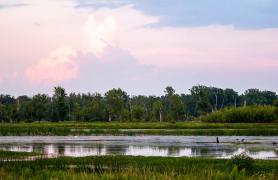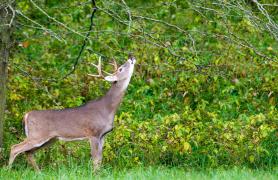To restore Missouri’s forests after the great timber liquidation of the late 1800s and early 1900s, the state encouraged landowners to limit burning to promote tree growth. In 1946, the Forest Crop Land (FCL) program became law and provided technical and financial assistance to landowners who would sign up for 25 years and agree to stop burning their property.
Since then, Missouri’s woods have changed. However, the importance of MDC staff working with private landowners has not. About 83 percent of Missouri’s 15.4 million acres of forest is privately owned. These private woodlands provide benefits for all Missourians, including a sustainable flow of forest products and the compatible benefits of creating and maintaining wildlife habitat, maintaining forest health, conserving soil resources, protecting water quality and quantity, providing places for recreation, and protecting and enhancing watershed function and quality. Professional management enhances the quality and quantity of values that flow from the forest. The need for forest management is as great as it has ever been.
Well-managed woodlands provide quality raw materials for Missouri’s forest products industry. The importance of this industry to the state’s economy can hardly be overstated. In 2015, forest products, wood, lumber, paper and related industries contributed $9.9 billion in direct and indirect benefits to the Missouri economy. These industries support nearly 47,000 jobs with an annual payroll of over $2.3 billion.
MDC’s Forestry Division has modified the 1946 FCL program to better fit with today’s conditions and renamed it Missouri Managed Woods (MMW). Like FCL before it, MMW is an entirely voluntary program.
Getting Started
MMW is designed to enhance the production of forest products and other forest values in Missouri by encouraging better management of privately-owned forested lands. This is accomplished through services and property tax reduction. Landowners must carry out responsible, long-term forest management in exchange for the benefits of the program.
Upon approval, enrolled lands are assigned a lower property tax value, which lasts for 15 years. MDC will pay the county annually for each acre of designated MMW land to make up the difference in tax revenue. Land may be re-enrolled in the program after the initial 15-year enrollment period is completed.
Start With a Plan
Managing land enrolled in MMW must be sustainable and guided by the goals and objectives of the landowner, as well as the condition of the trees present. After assessing the woods, a professional forester will write a plan that outlines activities designed to help achieve the landowner’s goals, while maintaining or improving the health of forest. Examples of goals are improving habitat for various kinds of wildlife and growing quality timber to maximize revenue. Often, several goals may be achieved at the same time.
Properly tended woodlands produce quality products, much the same as any other agricultural crop. Areas with few trees sometimes require planting. Crowded areas often need thinning to eliminate poorly formed trees or undesirable species.
Since there is often considerable variation in the types and ages of trees present, soil types, and other characteristics, each part of the woods must be considered separately. Then improvement activities may be tailored to each situation.
The 120 acres shown on the map below contains five different types of forest conditions ranging from dry ridgetop areas to bottomlands along a creek. Each type is suited to a different group of trees and other plants. Areas outlined in color show places that have been treated in the past few years to improve wildlife habitat and the health of the forest. Activities include removing red cedar trees from a dry, west-facing slope, which allowed native flowers and grasses to grow in the increased light, and conducting a commercial timber sale, which removed over-mature, low-quality black oak trees, creating conditions favorable to the growth of new tree seedlings.
Landowner Success:
Larry Strack
Larry Strack was the first landowner enrolled in MMW. He enrolled in December 2017, after learning about the program through his membership in the American Tree Farm® program and from his contact with MDC staff. Strack has been working with conservation professionals, including MDC foresters and private lands staff, private consulting foresters, and Natural Resources Conservation Service (NRCS) on his 120-acre farm since 2004 when his first forest stewardship plan was written. Strack owns his land for recreational purposes.
“I enjoy bowhunting and firearms hunting for deer and turkey,” Strack said. “I also squirrel hunt, take the grandkids fishing, hunt for mushrooms, pick blackberries, and watch and photograph wildlife.” Strack has a comprehensive plan for managing his woods, which guides his conservation activities.
“My goal is to improve wildlife habitat and water quality, reduce erosion, improve forest health and production, and leave a legacy for my children and grandchildren,” Strack said.
With the help of MMW, Strack has completed several projects to accomplish these goals. Some he has done himself, some with family and neighbors, and those that are beyond his capacity, he enlisted the aid of contractors.
Landowner Success:
The Haake Family
When Joe Haake Sr. bought 640 acres of mostly cut-over mid-Missouri timber land in 1961, he knew very little about managing a large tract of woods. He had bought the land as a place to hunt and as a weekend retreat from the city. Over time, weekend camping trips with his teenage son, Joe Haake Jr., began to include mowing, clearing some brush, and cutting down unwanted trees around the favored camp site. The work began to expand across the property. Old logging skid trails were expanded into a road network. Two years after buying the land, the entire property was burned by a wildfire. By 1966, Haake Sr. had learned about the enhanced fire protection offered to lands in the FCL program and soon enrolled his land.
As time passed, the land healed, ponds for wildlife were built, some pines were planted, and the native oaks and hickories regenerated after the period of intense burning ended. Meanwhile, the Haakes learned more about forestry from a local sawmill owner who was also a professional forester. In the mid-1980s, a detailed inventory and map was made of the property. This effort laid a foundation for more scientific management of the woods. The trees had grown enough to make forest stand improvement thinning cuts possible. The property was enrolled in the American Tree Farm System® in 1986, and Haake Sr. was named State and then U.S. Regional Tree Farmer of the Year in 1988. The property was reenrolled in FCL for a second 25-year period in 1992.
Ownership of the land passed to Haake Jr. in the 1990s, and the commitment to good forestry work continued. Selective logging, guided by consulting and MDC foresters, has continued on the property, always with the purpose of improving the overall quality of the woods, both for timber and to create better wildlife habitat.
Raised on the property, as was his father Haake Jr. before him, Mike Haake, the third generation of the family, assumed ownership of the property in 2010.
“My grandfather’s goal in managing the property was not short-term,” said Mike Haake. “It was always long-term, looking ahead 20 to 50 years.”
Mike continues the same approach. After the property expired out of the FCL program in 2017, it was enrolled in MMW in early 2018. Haake’s young family now spends weekends carrying on traditions begun over 50 years ago in the woods of mid-Missouri.
To learn more about Missouri Managed Woods, visit short.mdc.mo.gov/Zcr.




















Also In This Issue


And More...
This Issue's Staff
Associate Editor - Bonnie Chasteen
Staff Writer - Larry Archer
Staff Writer - Heather Feeler
Staff Writer - Kristie Hilgedick
Staff Writer - Joe Jerek
Creative Director - Stephanie Thurber
Art Director - Cliff White
Designer - Les Fortenberry
Designer - Marci Porter
Photographer - Noppadol Paothong
Photographer - David Stonner
Circulation - Laura Scheuler






















